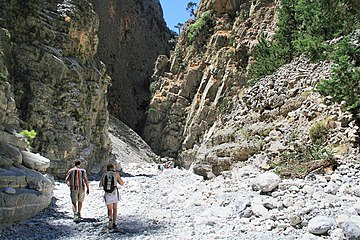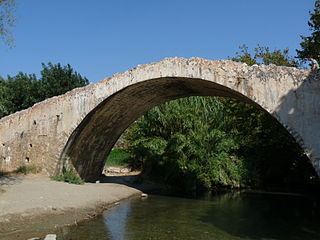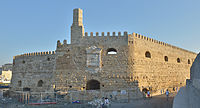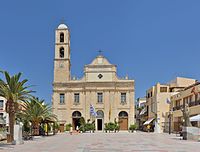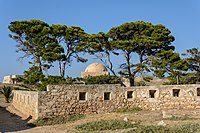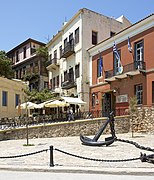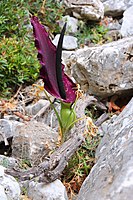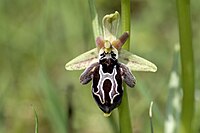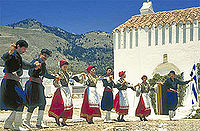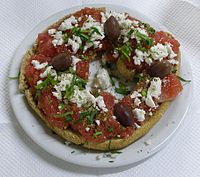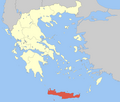Crete
Native name: Κρήτη | |
|---|---|
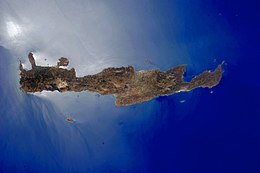 NASAphotograph of Crete | |
 | |
| Geography | |
| Location | Eastern Mediterranean |
| Coordinates | 35°12.6′N24°54.6′E/ 35.2100°N 24.9100°E |
| Area | 8,450 km2(3,260 sq mi) |
| Area rank | 88 |
| Highest elevation | 2,456 m (8058 ft) |
| Highest point | Mount Ida(Psiloritis) |
| Administration | |
| Region | Crete |
| Capital city | Heraklion |
| Largest settlement | Heraklion (pop. 144,442[1]) |
| Demographics | |
| Demonym | Cretan,archaicCretian |
| Population | 624,408 (2021)[2] |
| Population rank | 73 |
| Pop. density | 74.9/km2(194/sq mi) |
| Ethnic groups | Greeks; historically,Minoans, Eteocretans, Cydonians andPelasgians |
| Additional information | |
| Time zone |
|
| ISO code | GR-M |
| HDI(2019) 0.879[3] very high·3rd of 13 | |
Crete(/kriːt/KREET;Greek:Κρήτη,Modern:Kríti[ˈkriti],Ancient:Krḗtē[krɛ̌ːtεː]) is the largest and most populous of theGreek islands,the88thlargest island in the world and thefifth largest islandin theMediterranean Sea,afterSicily,Sardinia,Cyprus,andCorsica.Crete is located about 100 km (62 mi) south of the Peloponnese, and about 300 km (190 mi) southwest ofAnatolia.Crete has an area of 8,450 km2(3,260 sq mi) and a coastline of 1,046 km (650 mi). It bounds the southern border of theAegean Sea,with theSea of Crete(or North Cretan Sea) to the north and theLibyan Sea(or South Cretan Sea) to the south. Crete covers 260 km from west to east but is narrow from north to south, spanning three longitudes but only half a latitude.
Crete and a number of islands and islets that surround it constitute the Region of Crete (Greek:Περιφέρεια Κρήτης), which is the southernmost of the 13top-level administrative units of Greece,and the fifth most populous of Greece's regions. Its capital and largest city isHeraklion,on the north shore of the island. As of 2021[update],the region had a population of 624,408.[4]TheDodecaneseare located to the northeast of Crete, while theCycladesare situated to the north, separated by theSea of Crete.ThePeloponneseis to the region's northwest.
Crete was the center ofEurope's first advanced civilization, theMinoans,from 2700 to 1420 BC. The Minoan civilization was overrun by theMycenaean civilizationfrom mainland Greece. Crete was later ruled by Rome, then successively by theByzantine Empire,AndalusianArabs, theVenetian Republic,and theOttoman Empire.In 1898 Crete, whose people had for some time wanted to join the Greek state, achieved independence from the Ottomans, formally becoming theCretan State.Crete became part of Greece in December 1913.
The island is mostly mountainous, and its character is defined by a high mountain range crossing from west to east. It includes Crete's highest point,Mount Ida,and the range of theWhite Mountains(Lefka Ori) with 30 summits above 2,000 metres (6,600 ft) in altitude and theSamaria Gorge,aWorld Biosphere Reserve.Crete forms a significant part of the economy and cultural heritage of Greece, while retaining its own local cultural traits (such as its ownpoetryandmusic). TheNikos Kazantzakisairport at Heraklion and theDaskalogiannisairport atChaniaserve international travelers. TheMinoan palaceatKnossosis also located in Heraklion.[5]
Name
[edit]| Keftiu inhieroglyphs | ||||||
|---|---|---|---|---|---|---|
The earliest references to the island of Crete come from texts from theSyriancity ofMaridating from the18th centuryBC, where the island is referred to asKaptara.[6]This is repeated later inNeo-Assyrianrecords and theBible(Caphtor). It was known in ancientEgyptianasKeftiuorkftı͗w,strongly suggesting a similarMinoanname for the island.[7]
The current nameCreteis first attested in the 15th century BC inMycenaean Greektexts, written inLinear B,through the wordske-re-te(𐀐𐀩𐀳,*Krētes;later Greek:Κρῆτες[krɛː.tes],plural ofΚρής[krɛːs])[8]andke-re-si-jo(𐀐𐀩𐀯𐀍,*Krēsijos;later Greek:Κρήσιος[krέːsios],[9]'Cretan').[10][11]InAncient Greek,the name Crete (Κρήτη) first appears inHomer'sOdyssey.[12]Its etymology is unknown. One proposal derives it from a hypotheticalLuwianword*kursatta(comparekursawar'island',kursattar'cutting, sliver').[13]Another proposal suggests that it derives from theancient Greekword"κραταιή" (krataie̅),meaning strong or powerful, the reasoning being that Crete was the strongestthalassocracyduring ancient times.[14][15]
InLatin,the name of the island becameCreta.The original Arabic name of Crete wasIqrīṭiš(Arabic:اقريطش<(τῆς) Κρήτης),but after theEmirate of Crete's establishment of its new capital atربض الخندقRabḍ al-Ḫandaq(modernHeraklion;Greek:Ηράκλειο,Irákleio), both the city and the island became known asΧάνδαξ(Chandax) orΧάνδακας(Chandakas), which gave Latin, Italian, and VenetianCandia,from which were derived FrenchCandieand EnglishCandyorCandia.UnderOttoman rule,inOttoman Turkish,Crete was calledGirit(كريد). In the Hebrew Bible, Crete is referred to as (כְּרֵתִים) "kretim".
Physical geography and climate
[edit]



Crete is the largest island in Greece and the fifth largest island in theMediterranean Sea.It is located in the southern part of theAegean Seaseparating the Aegean from theLibyan Sea.
Island morphology
[edit]The island has an elongated shape: it spans 260 km (160 mi) from east to west, is 60 km (37 mi) at its widest point, and narrows to as little as 12 km (7.5 mi) (close toIerapetra). Crete covers an area of 8,336 km2(3,219 sq mi), with a coastline of 1,046 km (650 mi); to the north, it broaches theSea of Crete(Greek:Κρητικό Πέλαγος); to the south, theLibyan Sea(Greek:Λιβυκό Πέλαγος); in the west, theMyrtoan Sea,and toward the east the Carpathian Sea. It lies approximately 160 km (99 mi) south of the Greek mainland.
There are a number of peninsulas and gulfs on the north side of Crete, from west to east these include:Gramvousapeninsula, gulf of Kissamos, Rodopos peninsula,gulf of Chania,Akrotiripeninsula,Souda Bay,Apokoronas cape, gulf ofAlmiros,gulf ofHeraklion,Aforesmenos cape, gulf ofMirabello,gulf ofSitiaand theSiderospeninsula. On the south side of Crete is the gulf ofMessarasandCape Lithinon.
Mountains and valleys
[edit]Crete is mountainous, and its character is defined by a high mountain range crossing from west to east, formed by six different groups of mountains:
- The White Mountains orLefka Ori2,453 m (8,048 ft)
- The Idi Range (Psiloritis) 2,456 m (8,058 ft)
- Asterousia Mountains1,231 m (4,039 ft)
- Kedros1,777 m (5,830 ft)
- TheDikti Mountains2,148 m (7,047 ft)
- Thrypti1,489 m (4,885 ft)
These mountains lavish Crete with valleys, such asAmari valley,fertile plateaus, such asLasithi plateau,OmalosandNidha;caves, such asGourgouthakas,Diktaion,andIdaion(the birthplace of the ancient Greek godZeus); and a number of gorges.
The mountains have been seen as a key feature of the island's distinctiveness, especially since the time of Romantic travellers' writing. Contemporary Cretans distinguish between highlanders and lowlanders; the former often claim to reside in places affording a higher/better climatic and moral environment. In keeping with the legacy of Romantic authors, the mountains are seen as having determined their residents' 'resistance' to past invaders which relates to the oft-encountered idea that highlanders are 'purer' in terms of less intermarriages with occupiers. For residents of mountainous areas, such asSfakiain western Crete, the aridness and rockiness of the mountains is emphasised as an element of pride and is often compared to the alleged soft-soiled mountains of others parts of Greece or the world.[16]
Gorges, rivers and lakes
[edit]The island has a number of gorges, such as theSamariá Gorge,Imbros Gorge,Kourtaliotiko Gorge,Ha Gorge,Platania Gorge,the Gorge of the Dead (atKato Zakros,Sitia) andRichtis Gorgeand (Richtis) waterfall at Exo Mouliana inSitia.[17][18][19][20]
The rivers of Crete include theGeropotamos River,the Koiliaris, the Anapodiaris, the Almiros, the Giofyros, the Keritis, and Megas Potamos. There are only two freshwater lakes in Crete:Lake Kournasand Lake Agia, which are both inChania regional unit.[21]Lake Voulismeniat the coast, at Aghios Nikolaos, was formerly a freshwater lake but is now connected to the sea, inLasithi.[22]Three artificial lakes created by dams also exist in Crete: the lake ofAposelemis Dam,the lake of Potamos Dam, and the lake of Mpramiana Dam.
-
Aradaina Gorge
-
VenetianBridge over Megalopotamos River
Surrounding islands
[edit]
A large number of islands,islets,and rocks hug the coast of Crete. Many are visited by tourists, some are only visited byarchaeologistsandbiologists.Some areenvironmentally protected.A small sample of the islands includes:
- Gramvousa(Kissamos,Chania) the pirate island opposite the Balo lagoon
- Elafonisi(Chania), which commemorates a shipwreck and an Ottoman massacre
- Chrysiisland (Ierapetra,Lasithi), which hosts the largest naturalJuniperus macrocarpaforest in Europe
- Paximadiaisland (Agia Galini,Rethymno) where the god Apollo and the goddess Artemis were born
- The Venetian fort and leper colony atSpinalongaopposite the beach and shallow waters ofElounda(Agios Nikolaos,Lasithi)
- Dionysadesislands which are in an environmentally protected region together with the Palm Beach Forest ofVaiin the municipality ofSitia,Lasithi
Off the south coast, the island ofGavdosis located 26 nautical miles (48 km) south ofHora Sfakionand is thesouthernmostpoint ofEurope.
Climate
[edit]Crete straddles two climatic zones, theMediterraneanand thesemi-arid climate,mainly falling within the former. As such, the climate in Crete is primarily ahot-summer Mediterranean(Csa) climate while some areas in thesouthand east have ahot semi-arid climate(Köppen climate classification:BSh). The higher elevations fall into the warm-summerMediterranean climatecategory (Csb)[23]while the mountain peaks (>2,000 meters) might feature a cold-summerMediterranean climate(Csc) or acontinental climate(DfborDfc). The atmosphere can be quite humid, depending on the proximity to the sea, while winter is fairly mild. Snowfall is common on the mountains between November and May, but rare in the low-lying areas.

The south coast, including theMesara PlainandAsterousia Mountains,falls in the North African climatic zone, enjoying significantly more sunny days and high temperatures throughout the year. There,date palmsbear fruit, andswallowsremain year-round rather than migrate toAfrica.The fertile region aroundIerapetra,on the southeastern corner of the island, has year-round agricultural production, with summer vegetables and fruit produced ingreenhousesthroughout the winter.[24]Western Crete (Chania province) receives more rain and the soils there suffer more erosion compared to the Eastern part of Crete.[25]
Average annual temperatures reach up to 21.0°C in South Crete. Crete holds the record for the highest temperatures ever recorded inEuropeduring October, November, January and February fromWorld Meteorological Organizationstations.[26][27][28][29][30]According to theHellenic National Meteorological Service,South Crete receives the most sunshine inGreecewith more than 3,257 hours of sunshine per year.[31]
| Climate data for Heraklion 1955-2010 (HNMS) | |||||||||||||
|---|---|---|---|---|---|---|---|---|---|---|---|---|---|
| Month | Jan | Feb | Mar | Apr | May | Jun | Jul | Aug | Sep | Oct | Nov | Dec | Year |
| Record high °C (°F) | 29.9 (85.8) |
28.8 (83.8) |
34.0 (93.2) |
37.5 (99.5) |
38.0 (100.4) |
41.3 (106.3) |
43.6 (110.5) |
44.5 (112.1) |
39.5 (103.1) |
37.0 (98.6) |
32.8 (91.0) |
28.5 (83.3) |
44.5 (112.1) |
| Mean daily maximum °C (°F) | 15.3 (59.5) |
15.5 (59.9) |
17.0 (62.6) |
20.1 (68.2) |
23.6 (74.5) |
27.3 (81.1) |
28.9 (84.0) |
28.8 (83.8) |
26.6 (79.9) |
23.6 (74.5) |
20.2 (68.4) |
17.1 (62.8) |
22.0 (71.6) |
| Daily mean °C (°F) | 12.1 (53.8) |
12.2 (54.0) |
13.6 (56.5) |
16.6 (61.9) |
20.4 (68.7) |
24.5 (76.1) |
26.4 (79.5) |
26.3 (79.3) |
23.7 (74.7) |
20.3 (68.5) |
16.8 (62.2) |
13.8 (56.8) |
18.9 (66.0) |
| Mean daily minimum °C (°F) | 9.1 (48.4) |
8.9 (48.0) |
9.8 (49.6) |
12.0 (53.6) |
15.1 (59.2) |
19.2 (66.6) |
21.9 (71.4) |
22.0 (71.6) |
19.5 (67.1) |
16.7 (62.1) |
13.5 (56.3) |
10.9 (51.6) |
14.9 (58.8) |
| Record low °C (°F) | 0.0 (32.0) |
−0.8 (30.6) |
0.3 (32.5) |
4.2 (39.6) |
6.0 (42.8) |
12.2 (54.0) |
14.5 (58.1) |
16.6 (61.9) |
12.0 (53.6) |
8.7 (47.7) |
4.2 (39.6) |
2.4 (36.3) |
−0.8 (30.6) |
| Average rainfall mm (inches) | 91.0 (3.58) |
69.0 (2.72) |
53.4 (2.10) |
28.2 (1.11) |
13.4 (0.53) |
2.9 (0.11) |
0.8 (0.03) |
0.9 (0.04) |
16.7 (0.66) |
59.4 (2.34) |
59.6 (2.35) |
85.6 (3.37) |
480.9 (18.94) |
| Average rainy days | 16.0 | 13.6 | 11.4 | 7.6 | 4.6 | 1.3 | 0.3 | 0.5 | 2.8 | 7.5 | 10.6 | 15.2 | 91.4 |
| Averagerelative humidity(%) | 68.4 | 66.4 | 65.9 | 62.3 | 61.2 | 57.0 | 57.1 | 59.1 | 61.9 | 65.7 | 67.9 | 68.3 | 63.4 |
| Mean monthlysunshine hours | 119.9 | 132.3 | 181.5 | 234.8 | 298.5 | 356.2 | 368.3 | 343.5 | 275.8 | 206.9 | 145.5 | 115.4 | 2,778.6 |
| Source 1:HNMS[32][33] | |||||||||||||
| Source 2: meteo-climat (extremes)[34] | |||||||||||||
| Climate data forLentas | |||||||||||||
|---|---|---|---|---|---|---|---|---|---|---|---|---|---|
| Month | Jan | Feb | Mar | Apr | May | Jun | Jul | Aug | Sep | Oct | Nov | Dec | Year |
| Record high °C (°F) | 21.9 (71.4) |
25.2 (77.4) |
24.2 (75.6) |
29.7 (85.5) |
36.7 (98.1) |
39.6 (103.3) |
43.3 (109.9) |
42.7 (108.9) |
36.7 (98.1) |
33.2 (91.8) |
27.2 (81.0) |
23.3 (73.9) |
43.3 (109.9) |
| Mean daily maximum °C (°F) | 16.3 (61.3) |
16.7 (62.1) |
17.9 (64.2) |
21.3 (70.3) |
24.8 (76.6) |
29.0 (84.2) |
33.0 (91.4) |
32.8 (91.0) |
29.7 (85.5) |
25.7 (78.3) |
22.0 (71.6) |
18.2 (64.8) |
24.0 (75.1) |
| Daily mean °C (°F) | 13.8 (56.8) |
14.1 (57.4) |
15.2 (59.4) |
18.2 (64.8) |
21.6 (70.9) |
25.6 (78.1) |
29.4 (84.9) |
29.4 (84.9) |
26.6 (79.9) |
22.9 (73.2) |
19.4 (66.9) |
15.8 (60.4) |
21.0 (69.8) |
| Mean daily minimum °C (°F) | 11.3 (52.3) |
11.6 (52.9) |
12.4 (54.3) |
15.1 (59.2) |
18.3 (64.9) |
22.2 (72.0) |
25.8 (78.4) |
26.1 (79.0) |
23.5 (74.3) |
20.0 (68.0) |
16.9 (62.4) |
13.3 (55.9) |
18.0 (64.5) |
| Record low °C (°F) | 2.3 (36.1) |
2.3 (36.1) |
3.9 (39.0) |
7.8 (46.0) |
12.8 (55.0) |
16.3 (61.3) |
20.8 (69.4) |
22.3 (72.1) |
15.2 (59.4) |
14.3 (57.7) |
10.2 (50.4) |
5.3 (41.5) |
2.3 (36.1) |
| Average rainfall mm (inches) | 82.2 (3.24) |
61.7 (2.43) |
41.1 (1.62) |
13.6 (0.54) |
8.8 (0.35) |
5.4 (0.21) |
0.1 (0.00) |
1.1 (0.04) |
10.3 (0.41) |
30.2 (1.19) |
45.1 (1.78) |
61.0 (2.40) |
360.6 (14.21) |
| Source:National Observatory of AthensMonthly Bulletins (Dec 2011-Jan 2024)[35][36]andWorld Meteorological Organization[37] | |||||||||||||
Human geography
[edit]Crete is the most populous island in Greece with a population of more than 600,000 people. Approximately 42% live in Crete's main cities and towns whilst 45% live in rural areas.[38]
-
Venetian harbour inChania
-
Dusk airview of the Old Harbour ofRethymno
-
View of the harbour inHeraklion
-
The old harbour inAgios Nikolaos
Administration
[edit]Crete Region
| |
|---|---|
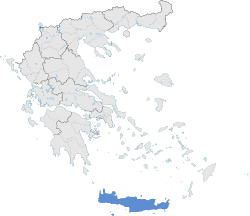 | |
| Coordinates:35°13′N24°55′E/ 35.21°N 24.91°E | |
| Country | |
| Established | 1912 |
| Capital | Heraklion |
| Regional units | |
| Government | |
| • Regional governor | Stavros Arnaoutakis(PASOK – Movement for Change) |
| Area | |
| • Total | 8,335.88 km2(3,218.50 sq mi) |
| Population (2021)[39] | |
| • Total | 624,408 |
| • Density | 75/km2(190/sq mi) |
| GDP | |
| • Total | €8.913 billion (2021) |
| Time zone | UTC+2(EET) |
| • Summer (DST) | UTC+3(EEST) |
| ISO 3166 code | GR-M |
| Website | www |
Crete with its nearby islands form theCrete Region(Greek:Περιφέρεια Κρήτης,Periféria Krítis,[periˈferiaˈkritis]), one of the 13regions of Greecewhich were established in the 1987 administrative reform.[41]Under the 2010Kallikratis plan,the powers and authority of the regions were redefined and extended. The region is based atHeraklionand is divided into fourregional units(pre-Kallikratisprefectures). From west to east these are:Chania,Rethymno,Heraklion,andLasithi.These are further subdivided into 24municipalities.
Since 1 January 2011, the regional governor isStavros Arnaoutakisof thePanhellenic Socialist Movement.First elected in2010,he was re-elected in2014,2019and2023.
Cities
[edit]Heraklionis the largest city and capital of Crete, holding more than a fourth of the island's population.Chaniawas the capital until 1971. The principal cities are:
- Heraklion(IraklionorCandia) (144,422 inhabitants)[42]
- Chania(Haniá) (88,525 inhabitants)[42]
- Rethymno(34,300 inhabitants)[42]
- Ierapetra(23,707 inhabitants)
- Agios Nikolaos(20,679 inhabitants)
- Sitia(14,338 inhabitants)
-
Venetian fortress inHeraklion
-
Chaniacathedral
-
RethymnoFortezza Mosque
-
Kazarma fortressat the top inSitia
Demographics
[edit]According to official census data by theHellenic Statistical Authority,the region's population has increased by 1,343 people between 2011 and 2021, experiencing a rise of 0.22%.[43]The island is home to 308,608 men and 315,800 women, accounting for 49.4% and 50.6% of the population respectively.
| Crete | 1981 | 1991 | 2001 | 2011 | 2021 |
|---|---|---|---|---|---|
| Population | 502,165 | 540,054 | 601,131 | 623,065 | 624,408 |
| Change | --- --- --- | +7.27% | +10.7% | +3.58% | +0.22% |
Graphs are unavailable due to technical issues. There is more info onPhabricatorand onMediaWiki.org. |
The island is divided into four regional units, Heraklion, Rethymno, Chania, and Lasithi.
| Regional Unit | Population (2021) | Change between 2011 and 2021 (%) |
|---|---|---|
| Heraklion | 305,017 | -0.2% |
| Lasithi | 77,819 | +3.2% |
| Rethymno | 84,866 | -0.9% |
| Chania | 156,706 | +0.1% |
Economy
[edit]The economy of Crete is predominantly based on services and tourism. However, agriculture also plays an important role and Crete is one of the few Greek islands that can support itself without a tourism industry.[44]The economy began to change visibly during the 1970s as tourism gained in importance. Although an emphasis remains on agriculture and stock breeding, because of the climate and terrain of the island, there has been a drop in manufacturing, and an observable expansion in its service industries (mainly tourism-related). All three sectors of the Cretan economy (agriculture/farming, processing-packaging, services), are directly connected and interdependent. The island has a per capita income much higher than the Greek average, whereas unemployment is at approximately 4%, one-sixth of that of the country overall.[citation needed][when?]
As in many regions of Greece,viticultureandolivegroves are significant;oranges,citronsandavocadoesare also cultivated. Until recently[when?]there were restrictions on the import of bananas to Greece, therefore bananas were grown on the island, predominantly in greenhouses. Dairy products are important to the local economy and there are a number of specialty cheeses such asmizithra,anthotyros,andkefalotyri.
20% of Greek wine is produced in Crete, mostly in the region of Peza.[45]
TheGross domestic product(GDP) of the region was €9.4 billion in 2018, accounting for 5.1% of Greek economic output. GDP per capita adjusted for purchasing power was €17,800 or 59% of the EU27 average in the same year. The GDP per employee was 68% of the EU average. Crete is the region in Greece with the fifth highest GDP per capita.[46]
Transport infrastructure
[edit]Airports
[edit]The island has three significant airports,Nikos Kazantzakisat Heraklion, theDaskalogiannisairport at Chania and the smallerSitiaairport. The first two serve international routes, acting as the main gateways to the island for travellers. Work has begun plan to replace Heraklion airport with a new airport atKasteli,where there is presently an air force base, and the new Kasteli Airport is due to open by 2027.
Ferries
[edit]The island is well served by ferries, mostly fromPiraeus,by ferry companies such asMinoan LinesandANEK Lineswith links to theCycladesandDodecaneseislands.Seajetsalso operates routes toCyclades.
The main ports from west to east are atKissamos(ferry link to Peloponnese),Souda(Chania),Rethymno,Heraklion(links to Cyclades),Agios NikolaosandSitia(link to Dodecanese).
Road network
[edit]
Most of Crete is served by the road network. A modern highway is currently being upgraded along the north coast connecting the four major cities (Motorway 90), the sections bypassing the main cities (Heraklion to Malia, Rethymno, Chania to Kolymvari) are at motorway standard, while the sections in between, and west to Kissamos and east to Sitia, should be completed by 2028. A link will also connect to the newKasteli international airport.[47]
In addition, aEuropean Unionstudy has been devised to promote a modern highway to connect the northern and southern parts of the island via atunnel.The study proposal includes a 15.7 km (9.8 mi) section of road between the villages of Agia Varvara and Agia Deka in central Crete. The new road section forms part of the route betweenMessarain the south and Crete's largest cityHeraklion,which houses the island's biggest airport and ferry links with mainlandGreece.
Railway
[edit]Also, during the 1930s there was a narrow-gauge industrial railway in Heraklion, from Giofyros in the west side of the city to the port. There are now no railway lines on Crete. The government is planning the construction of a line from Chania to Heraklion via Rethymno.[48][49]
Development
[edit]The construction sector in Crete responded well during the pandemic and has come out strong in the post-recession recovery period. Total construction spending recovered and is expected to peak a record high (approximately 8% higher than 2019 average levels) signalling consistent expansion in construction projects and real estate investments in Crete.[50]The evolution of the private sector in Crete is tightly linked with the demand for tourism-related investments. Moreover, the recovery of the tourism sector is expected to lead to further growth in housing prices and rental demand.
Newspapers have reported that the Ministry of Mercantile Marine is ready to support the agreement between Greece,South Korea,Dubai Ports WorldandChinafor the construction of a large internationalcontainerport andfree trade zonein southern Crete nearTympaki;the plan is to expropriate 850 ha (2,100 acres) of land. The port would handle two million containers per year, but the project has not been universally welcomed because of its environmental, economic and cultural impact.[51]As of January 2013, the project has still not been confirmed, although there is mounting pressure to approve it, arising from Greece's difficult economic situation.
There are plans for underwater cables going from mainland Greece to Israel and Egypt passing by Crete and Cyprus:EuroAfrica InterconnectorandEuroAsia Interconnector.[52][53]They would connect Crete electrically with mainland Greece, ending energy isolation of Crete. At present Greece covers electricity cost differences for Crete of around €300 million per year.[54]
History
[edit]


In the later Neolithic and Bronze Age periods, under the Minoans, Crete had a highly developed, literate civilization. It has been ruled by various ancient Greek entities, theRoman Empire,theByzantine Empire,theEmirate of Crete,theRepublic of Veniceand theOttoman Empire.After a brief period of independence (1897–1913) under a provisional Cretan government, it joined the Kingdom of Greece. It was occupied byNazi Germanyduring theSecond World War.
Prehistory
[edit]Stone tools suggest thatarchaic humansmay have visited Crete as early as 130,000 years ago, but there is no evidence of permanent settlement of the island until theNeolithic,around 7,000 BCE.[55]Settlements dating to theaceramicNeolithic in the 7th millennium BC, usedcattle,sheep,goats,pigsanddogsas well as domesticatedcerealsandlegumes;ancientKnossoswas the site of one of these major Neolithic (then later Minoan) sites.[56]Other neolithic settlements include those atKephala,Magasa,andTrapeza.
Minoan civilization
[edit]During theBronze Age,Crete was the centre of theMinoan civilization,notable for itsart,its writing systems such asLinear A,and for its massive building complexes including the palace atKnossos.Its economy benefited from a network of trade around much of theMediterranean,and Minoan cultural influence extended toCyprus,Canaan,andEgypt.Some scholars have speculated thatlegendssuch as that of theminotaurhave a historical basis in Minoan times.
Mycenaean civilization
[edit]In 1420 BC, the Minoan civilization was subsumed by theMycenaean civilizationfrom mainland Greece. The oldest samples of writing in the Greek language, as identified byMichael Ventris,is the Linear B archive from Knossos, dated approximately to 1425–1375 BC.[57]
Archaic and Classical period
[edit]After theBronze Age collapse,Crete was settled by new waves of Greeks from the mainland. A number of city states developed in theArchaic period.There was limited contact with mainland Greece, andGreek historiographyshows little interest in Crete, as a result, there are few literary sources.
During the 6th to 4th centuries BC, Crete was comparatively free from warfare. TheGortyn code(5th century BC) is evidence for how codifiedcivil lawestablished a balance between aristocratic power and civil rights.
In the late 4th century BC, the aristocratic order began to collapse due to endemic infighting among the elite, and Crete's economy was weakened by prolonged wars between city states. During the 3rd century BC,Gortyn,Kydonia (Chania),LyttosandPolyrrheniachallenged the primacy of ancient Knossos.
While the cities continued to prey upon one another, they invited into their feuds mainland powers likeMacedonand its rivalsRhodesandPtolemaic Egypt.In 220 BC the island was tormented by awar between two opposing coalitions of cities.As a result, the Macedonian kingPhilip Vgainedhegemonyover Crete which lasted to the end of theCretan War (205–200 BC),when theRhodiansopposed the rise of Macedon and theRomansstarted to interfere in Cretan affairs.
In the 2nd century BC Ierapytna (Ierapetra) gained supremacy on eastern Crete.
Roman rule
[edit]Crete was involved in theMithridatic Wars,initially repelling an attack by Roman generalMarcus Antonius Creticusin 71 BC. Nevertheless, a ferocious three-year campaign soon followed underQuintus Caecilius Metellus,equipped with three legions. Crete was conquered by Rome in 69 BC, earning for Metellus the title "Creticus".Gortynwas made capital of the island, and Crete became a Roman province, along withCyrenaicathat was calledCreta et Cyrenaica.Archaeological remains suggest that Crete under Roman rule witnessed prosperity and increased connectivity with other parts of the Empire.[58]In the 2nd century AD, at least three cities in Crete (Lyttos, Gortyn, Hierapytna) joined thePanhellenion,a league of Greek cities founded by the emperorHadrian.WhenDiocletianredivided the Empire, Crete was placed, along with Cyrene, under thediocese of Moesia,and later byConstantine Ito thediocese of Macedonia.
Byzantine Empire – first period
[edit]
Crete was separated from Cyrenaicac. 297.It remained a province within the eastern half of the Roman Empire, usually referred to as the Eastern Roman (Byzantine) Empire after the establishment of a second capital in Constantinople by Constantine in 330. Crete was subjected to an attack byVandalsin 467, the great earthquakes of365and 415, a raid bySlavsin 623, Arab raids in 654 and the 670s, and again in the 8th century. Inc. 732,the EmperorLeo III the Isauriantransferred the island from the jurisdiction of thePopeto that of thePatriarchate of Constantinople.[59]
Arab rule
[edit]
In the 820s, after 900 years as a Roman island, Crete was captured by AndalusianMuwalladsled byAbu Hafs,[60]who established theEmirate of Crete.The Byzantines launched a campaign that took most of the island back in 842 and 843 underTheoktistos.Further Byzantine campaigns in 911 and 949 failed. In 960–61,Nikephoros Phokas'campaignrestored Crete to the Byzantine Empire, after a century and a half of Arab control.
Byzantine Empire – second period
[edit]In 961,Nikephoros Phokasreturned the island to Byzantine rule after expelling the Arabs.[61]Extensive efforts at conversion of the populace were undertaken, led byJohn XenosandNikon "the Metanoeite".[62][63]The reconquest of Crete was a major achievement for the Byzantines, as it restored Byzantine control over the Aegean littoral and diminished the threat ofSaracenpirates, for which Crete had provided a base of operations.
In 1204, theFourth Crusadeseized and sacked the imperial capital ofConstantinople.Crete was initially granted to leading CrusaderBoniface of Montferrat[61]in the partition of spoils that followed. However, Boniface sold his claim to theRepublic of Venice,[61]whose forces made up the majority of the Crusade. Venice's rival theRepublic of Genoaimmediately seized the island and it was not until 1212 that Venice secured Crete as a colony.
Venetian rule
[edit]
From 1212, duringVenice's rule, which lasted more than four centuries, aRenaissanceswept through the island as is evident from the artistic works dating to that period. Known asThe Cretan SchoolorPost-Byzantine Art,it is among the last flowerings of the artistic traditions of the fallen empire. This included the painterEl Grecoand the writersNicholas Kalliakis(1645–1707),Georgios Kalafatis (professor)(c. 1652–1720),Andreas Musalus(c. 1665–1721) andVitsentzos Kornaros.[64][65][66]
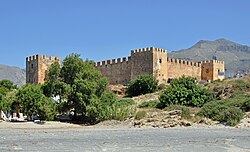
Under the rule of the CatholicVenetians,the city ofCandiawas reputed to be the best fortified city of theEastern Mediterranean.[67]The three main forts were located atGramvousa,Spinalonga,andFortezzaat Rethymnon. Other fortifications include theKazarma fortressat Sitia andFrangokastelloin Sfakia.
In 1492, Jews expelled from Spain settled on the island.[68]In 1574–77, Crete was under the rule ofGiacomo Foscarinias Proveditor General, Sindace andInquisitor.According to Starr's 1942 article, the rule of Giacomo Foscarini was a Dark Age for Jews and Greeks. Under his rule, non-Catholics had to pay high taxes with no allowances. In 1627, there were 800 Jews in the city of Candia, about seven percent of the city's population.[69]Marco Foscariniwas the Doge of Venice during this time.
Ottoman rule
[edit]



The Ottomansconquered Crete(Girit Eyâleti) in 1669, after thesiege of Candiawith the last Venetian strongholds off Crete falling in the lastOttoman–Venetian Warin 1715. Many Greek Cretans fled to other regions of theRepublic of Veniceafter theOttoman–Venetian Wars,some even prospering such as the family ofSimone Stratigo(c. 1733 – c. 1824) who migrated toDalmatiafrom Crete in 1669.[70]
Islamicpresence on the island, aside from the interlude of theArab occupation,was cemented by theOttoman conquest.MostCretan Muslimswere local Greek converts who spoke CretanGreek,but in the island's 19th-century political context they came to be viewed by the Christian population as Turks.[71]Contemporary estimates vary, but on the eve of theGreek War of Independence(1830), as much as 45% of the population of the island may have been Muslim.[72]A number ofSufiorders were widespread throughout the island, theBektashiorder being the most prevalent, possessing at least fivetekkes.ManyCretan Turksfled Crete because of the unrest, settling in Turkey, Rhodes, Syria, Libya and elsewhere. By 1900, 11% of the population was Muslim. Those remaining were relocated in the 1924population exchange between Greece and Turkey.[73]
During Easter of 1770, a revolt against Ottoman rule in Crete was started byDaskalogiannis,a shipowner fromSfakiawho was promised support byOrlov's fleetwhich never arrived. Daskalogiannis eventually surrendered to the Ottoman authorities. Today, the airport at Chania is named after him.[citation needed]
During theGreek war of independence,SultanMahmud IIgranted rule over Crete to Egypt's rulerMuhammad Ali Pashain exchange for his military support. Crete was subsequently left out of the new Greek state established under theLondon Protocol of 1830.Its administration by Muhammad Ali was confirmed in theConvention of Kütahyaof 1833, but direct Ottoman rule was re-established by theConvention of Londonof 3 July 1840.[citation needed]
Heraklion was surrounded by high walls and bastions and extended westward and southward by the 17th century. The most opulent area of the city was the northeastern quadrant where the elite were gathered. The city had received another name under the rule of the Ottomans, "the deserted city".[67]The urban policy that the Ottoman applied to Candia was a two-pronged approach.[67]The first was the religious endowments. It made the Ottoman elite contribute to building and rehabilitating the ruined city. The other method was to boost the population and the urban revenue by selling off urban properties. According to Molly Greene (2001) there were numerous records ofreal-estatetransactions during theOttomanrule. In the deserted city, minorities received equal rights in purchasing property. Christians and Jews were also able to buy and sell in the real-estate market.
TheCretan Revolt of 1866–1869or Great Cretan Revolution (Greek:Κρητική Επανάσταση του 1866) was a three-year uprising against Ottoman rule, the third and largest in a series of revolts between the end of the Greek War of Independence in 1830 and the establishment of the independent Cretan State in 1898. A particular event which caused strong reactions among the liberal circles of western Europe was theHolocaust of Arkadi.The event occurred in November 1866, as a large Ottoman force besieged theArkadi Monastery,which served as the headquarters of the rebellion. In addition to its 259 defenders, over 700 women and children had taken refuge in the monastery. After a few days of hard fighting, the Ottomans broke into the monastery. At that point, the abbot of the monastery set fire to the gunpowder stored in the monastery's vaults, causing the death of most of the rebels and the women and children sheltered there.[citation needed]
Cretan State 1898–1908
[edit]
Following the repeated uprisings in 1841, 1858, 1889, 1895 and 1897 by the Cretan people, who wanted to join Greece, theGreat Powersdecided to restore order and in February 1897 sent in troops. The island was subsequently garrisoned by troops from Great Britain, France, Italy and Russia; Germany and Austro-Hungary withdrawing from the occupation in early 1898. During this period Crete was governed through a committee of admirals from the remaining four Powers. In March 1898 the Powers decreed, with the reluctant consent of the Sultan, that the island would be granted autonomy under Ottomansuzeraintyin the near future.[74]
In September 1898 theCandia massacrein Candia, modern Heraklion, left over 500 Cretan Christians and 14 British servicemen dead at the hands of Muslim irregulars. As a result, the Admirals ordered the expulsion of all Ottoman troops and administrators from the island, a move that was ultimately completed by early November. The decision to grant autonomy to the island was enforced and a High Commissioner,Prince George of Greece,appointed, arriving to take up his post in December 1898.[75]The flag of theCretan Statewas chosen by the Powers, with the white star representing the Ottoman suzerainty over the island.
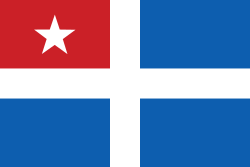
In 1905, disagreements between Prince George and minister Eleftherios Venizelos over the question of theenosis(union with Greece), such as the Prince's autocratic style of government, resulted in theTheriso revolt,one of the leaders beingEleftherios Venizelos.
Prince George resigned as High Commissioner and was replaced byAlexandros Zaimis,a former Greek prime minister, in 1906. In 1908, taking advantage of domestic turmoil in Turkey as well as the timing of Zaimis's vacation away from the island, the Cretan deputies unilaterally declared union with Greece.
With the outbreak of theFirst Balkan War,the Greek government declared that Crete was now Greek territory. This was not recognised internationally until 1 December 1913.[75]
Second World War
[edit]

During World War II, the island was the scene of theBattle of Cretein May 1941. The initial 11-day battle was bloody and left more than 11,000 soldiers and civilians killed or wounded. As a result of the fierce resistance from both Allied forces and civilian Cretan locals, the invasion force suffered heavy casualties, andAdolf Hitlerforbade further large-scaleparatroopoperations for the rest of the war.
During the initial and subsequent occupation, German firing squads routinely executed male civilians in reprisal for the death of German soldiers; civilians were rounded up randomly in local villages for the mass killings, such as at theMassacre of Kondomariand theViannos massacres.Two German generals were later tried and executed for their roles in the killing of 3,000 of the island's inhabitants.[76]
Following the collapse of fronts elsewhere in Europe, German forces evacuated most of Crete in October 1944 leaving an area including Chania under occupation. The following year the day afterVE Daythe remaining Germans under GeneralmajorHans-Georg Benthacksurrendered atKnossosto British Major-GeneralColin Callander.[77]
Civil War
[edit]In the aftermath of theDekemvrianain Athens, Cretan leftists were targeted by the right-wing paramilitary organization National Organization of Rethymno (EOR), which engaged in attacks in the villages of Koxare and Melampes, as well as Rethymno in January 1945. Those attacks did not escalate into a full-scale insurgency as they did in the Greek mainland and the CretanELASdid not surrender its weapons after theTreaty of Varkiza.An uneasy truce was maintained until 1947, with a series of arrests of notable communists in Chania and Heraklion. Encouraged by orders from the central organization in Athens, KKE launched an insurgency in Crete; marking the beginning of theGreek Civil Waron the island. In eastern Crete theDemocratic Army of Greece(DSE) struggled to establish its presence inDiktiandPsilorites.On 1 July 1947, the surviving 55 fighters of DSE were ambushed south of Psilorites, the few surviving members of the unit managed to join the rest of DSE inLefka Ori.[78]
TheLefka Oriregion in the west offered more favourable conditions for DSE's insurgency. In the summer of 1947 DSE raided and looted theMaleme Airportand motor depot at Chrysopigi. Its numbers swelled to approximately 300 fighters. The rise of DSE numbers compounded with crop failure on the island created serious logistical issues for the insurgents. The communists resorted tocattle rustlingand crop confiscations which solved the problem only temporarily. In the autumn of 1947, the Greek government offered generous amnesty terms to Cretan DSE fighters and mountain bandits, many of whom opted to abandon armed struggle or defect to the nationalists. On 4 July 1948, government troops launched a large scale offensive onSamariá Gorge.Many DSE soldiers were killed in the fighting while the survivors broke into small armed bands. In October 1948, the secretary of the Cretan KKE Giorgos Tsitilos was killed in an ambush. By the following month only 34 DSE fighters remained active in Lefka Ori. The insurgency in Crete gradually withered away, with the last two hold outs surrendering in 1974, 25 years after the conclusion of the war in mainland Greece.[79]
Tourism
[edit]

Crete is one of the most popular holiday destinations in Greece. 15% of all arrivals in Greece come through the city of Heraklion (port and airport), while charter journeys to Heraklion make up about20% of all charter flights in GreeceArchived29 July 2020 at theWayback Machine.The number of hotel beds on the island increased by 53% in the period between 1986 and 1991.
Today, the island's tourism infrastructure includes a wide range of accommodation; including large luxury hotels with their complete facilities, swimming pools, sports and recreation, smaller family-owned apartments, camping facilities and others. Visitors reach the island via two international airports in Heraklion andChaniaand a smaller airport inSitia(international charter and domestic flights started in May 2012)[80]or by boat to the main ports of Heraklion, Chania,Rethimno,Agios NikolaosandSitia.
Popular tourist attractions include the archaeological sites of the Minoan civilisation, the Venetian old city and port ofChania,the Venetian castle atRethymno,the gorge ofSamaria,the islands ofChrysi,Elafonisi,Gramvousa,Spinalongaand the Palm Beach ofVai,which is the largest natural palm forest in Europe.
Transportation
[edit]Crete has an extensive bus system with regular services across the north of the island and from north to south. There are two regional bus stations in Heraklion. Bus routes and timetables can be found on KTEL website.[81]
Holiday homes and immigration
[edit]Crete's mild climate attracts interest fromnorthern Europeanswho want a holiday home or residence on the island.EUcitizens have the right to freely buy property and reside with little formality.[82]In the cities of Heraklion and Chania, the average price per square metre of apartments ranges from €1,670 to €1,700.[83]A growing number of real estate companies cater mainly to British immigrants, followed byDutch,German,Scandinavianand other European nationalities wishing to own a home in Crete. TheBritishimmigrants are concentrated in the western regional units ofChaniaandRethymnoand to a lesser extent inHeraklionandLasithi.[48]
Archaeological sites and museums
[edit]The area has a large number of archaeological sites, including the Minoan sites ofKnossos,Malia(not to be confused with the town of the same name), Zakros,PetrasandPhaistos,the classical site ofGortys,and the diverse archaeology of the island ofKoufonisi,which includes Minoan, Roman, and World War II era ruins (nb. due to conservation concerns, access to Koufonisi has been restricted for the last few years).
There are museums throughout Crete. TheHeraklion Archaeological Museumdisplays most of the archaeological finds from the Minoan era and was reopened in 2014.[84]
Harmful effects
[edit]Helen Briassoulis, in a qualitative analysis, proposed in theJournal of Sustainable Tourismthat Crete is affected by tourism applying pressure to it to develop at an unhealthy rate, and that informal, internal systems within the country are forced to adapt. According to her, these forces have strengthened in three stages: from the period from 1960 to 1970, 1970–1990, and 1990 to the present. During this first period, tourism was a largely positive force, pushing modern developments like running water and electricity onto the largely rural countryside. However, beginning in the second period and especially in the third period leading up to the present day, tourist companies became more pushy with deforestation and pollution of Crete's natural resources. The country is then pulled into an interesting parity, where these companies only upkeep those natural resources that are directly essential to their industry.[85]
-
View ofGortyn
-
Archaeological site ofPhaistos
-
Ruins of thePalace of Knossos
-
Archeological Museum ofChania
-
Crete Naval museum
-
Jars inMalia,Crete
Fauna and flora
[edit]Fauna
[edit]Crete is isolated from mainland Europe, Asia, and Africa, and this is reflected in the diversity of the fauna and flora. As a result, the fauna and flora of Crete have many clues to the evolution of species. There are no animals that are dangerous to humans on the island of Crete in contrast to other parts of Greece. Indeed, the ancient Greeks attributed the lack of large mammals such as bears, wolves, jackals, and venomous snakes, to the labour ofHercules(who took a live Cretan bull to thePeloponnese). Hercules wanted to honor the birthplace of Zeus by removing all "harmful" and "venomous" animals from Crete. Later, Cretans believed that the island was cleared of dangerous creatures by theApostle Paul,who lived on the island of Crete for two years, with his exorcisms and blessings.
TheNatural History Museum of Crete,operates under the direction of theUniversity of Creteand two aquariums –AquaworldinHersonissosandCretaquariumin Gournes, display sea creatures common in Cretan waters.
Prehistoric fauna
[edit]Dwarf elephants,dwarf hippopotamus,dwarf mammoths,dwarf deer,andgiant flightless owlswere native toPleistoceneCrete.[86][87]Their ancestors could have reached the island in the time of theMessinian salinity crisis.
Mammals
[edit]Mammals of Crete include the vulnerablekri-kri,Capra aegagrus creticathat can be seen in the national park of theSamaria Gorgeand onThodorou,[88]DiaandAgioi Pantes(islets off the north coast), theCretan wildcatand theCretan spiny mouse.[89][90][91][92]Other terrestrial mammals include subspecies of the Cretan marten, the Cretan weasel, the Cretan badger, the Cretan wildcat,[93]thelong-eared hedgehog,and theedible dormouse.[94]
TheCretan shrew,a type ofwhite-toothed shrewis consideredendemicto the island of Crete because this species of shrew is unknown elsewhere. It is arelic speciesof theCrocidurashrews of whichfossilshave been found that can be dated to thePleistoceneera. Today it can only be found in the highlands of Crete.[95]It is considered to be the only surviving remnant of the endemic species of the Pleistocene Mediterranean islands.[96]
Bat species include:Blasius's horseshoe bat,thelesser horseshoe bat,thegreater horseshoe bat,thelesser mouse-eared bat,Geoffroy's bat,thewhiskered bat,Kuhl's pipistrelle,thecommon pipistrelle,Savi's pipistrelle,theserotine bat,thelong-eared bat,Schreibers' batand theEuropean free-tailed bat.[97]
-
TheKri-kri(the Cretan ibex) lives in protected natural parks at the gorge of Samaria and the island of Agios Theodoros.
-
Male Cretan ibex
-
Cretan Houndor Kritikos Lagonikos, one of Europe's oldest hunting dog breeds
Birds
[edit]Varieties of birds include eagles (can be seen inLasithi), swallows (throughout Crete in the summer and year-round in the south of the island),pelicans(along the coast), andcommon cranes(includingGavdosandGavdopoula). The Cretan mountains and gorges are refuges for the endangeredlammergeiervulture. Bird species include: thegolden eagle,Bonelli's eagle,thebearded vultureor lammergeier, thegriffon vulture,Eleonora's falcon,peregrine falcon,lanner falcon,European kestrel,tawny owl,little owl,hooded crow,alpine chough,red-billed chough,and theEurasian hoopoe.[98][99]The population of griffon vultures in Crete is the largest insular one of the species in the world and consists of the majority of the griffon vulture population in Greece.[100]
Reptiles and amphibians
[edit]Tortoises can be seen throughout the island. Snakes can be found hiding under rocks. Toads and frogs reveal themselves when it rains.
Reptiles include theAegean wall lizard,Balkan green lizard,common chameleon,ocellated skink,snake-eyed skink,moorish gecko,Turkish gecko,Kotschy's gecko,spur-thighed tortoise,and theCaspian turtle.[97][101]
There are four species of snake on the island and these are not dangerous to humans. The four species include theleopard snake(locally known as Ochendra), theBalkan whip snake(locally called Dendrogallia), thedice snake(called Nerofido in Greek), and the only venomous snake is the nocturnalcat snakewhich has evolved to deliver a weak venom at the back of its mouth to paralyse geckos and small lizards, and is not dangerous to humans.[97][102]
Sea turtles include thegreen turtleand theloggerhead turtlewhich are both threatened species.[101]The loggerhead turtle nests and hatches on north-coast beaches around Rethymno and Chania, and south-coast beaches along the gulf of Mesara.[103]
Amphibians include theEuropean green toad,American bullfrog(introduced),European tree frog,and theCretan marsh frog(endemic).[97][101][104]
Arthropods
[edit]Cicadas,known locally asTzitzikia,make a distinctive repetitivetzi tzisoundthat becomes louder and more frequent on hot summer days. Butterfly species include theswallowtail butterfly.[97]Moth species include thehummingbird moth.[105]There are several species of scorpion such asEuscorpiuscarpathicus whose venom is generally no more potent than a mosquito bite.
Crustaceans and molluscs
[edit]River crabs include the semi-terrestrialPotamon potamioscrab.[97]Edible snails are widespread and can cluster in the hundreds waiting for rainfall to reinvigorate them.
Sealife
[edit]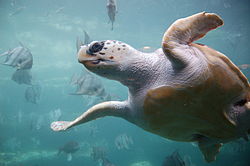
Apart from terrestrial mammals, the seas around Crete are rich in large marine mammals. The endangeredMediterranean monk seallives in almost all the coasts of the country. The area south of Crete, known as the Greek Abyss, hostswhales,sperm whales,dolphinsandporpoises.[106]The Minoan frescoes depicting dolphins in Queen's Megaron at Knossos indicate that Minoans were well aware of and celebrated these creatures.Squid,octopus,sea turtlesandhammerhead sharkslive or traverse along the coast.
Some of the fish of the waters around Crete include:scorpion fish,dusky grouper,east Atlantic peacockwrasse,five-spotted wrasse,weever fish,common stingray,brown ray,mediterranean black goby,pearly razorfish,star-gazer,painted comber,damselfish,and theflying gurnard.[107]
TheCretaquariumand theAquaworld Aquarium,are two of the three aquariums in the Greece. They are located inGournesandHersonissosrespectively.[108][109]
Flora
[edit]The Minoans contributed to the deforestation of Crete. Further deforestation occurred in the 1600s "so that no more local supplies of firewood were available".[110]
Common wildflowers include: camomile, daisy, gladiolus, hyacinth,iris,poppy, cyclamen and tulip, among others.[111]There are more than 200 different species of wildorchidon the island and this includes 14 varieties ofOphrys cretica.[112]Crete has a rich variety of indigenous herbs including commonsage,rosemary,thyme,andoregano.[112][113]Rare herbs include the endemicCretan dittany.[112][113]andironwort,Sideritis syriaca,known asMalotira(Μαλοτήρα). Varieties of cactus include the edibleprickly pear.Common trees on the island include thechestnut,cypress,oak,olive tree,pine,plane,andtamarisk.[113]Trees tend to be taller to the west of the island where water is more abundant.
-
Snake lily (Dracunculus vulgaris)
-
TheOphrys creticaorchid.
Environmentally protected areas
[edit]Environmentally protected areas include the island ofElafonision the coast of southwestern Crete, the palm forest ofVaiin eastern Crete and theDionysades(both in the municipality ofSitia,Lasithi).Vaihas a palm beach and is the largest natural palm forest in Europe. The island ofChrysi,15 kilometres (9 miles) south ofIerapetra,has the largest naturally-grownJuniperus macrocarpaforest in Europe.Samaria Gorgeis aWorld Biosphere ReserveandRichtis Gorgeis protected for its landscape diversity. Also, Sitia UNESCO Global Geopark, added in 2015 in UNESCO Geoparks, is located on the easternmost edge of Crete.
Mythology
[edit]
Crete has a strong association with ancientGreek godsbut is also connected with theMinoan civilization.
According toGreek mythology,theDiktaean Caveat MountDiktiwas the birthplace of the godZeus.ThePaximadiaislands were the birthplace of the goddessArtemisand the godApollo.Their mother, the goddessLeto,was worshipped atPhaistos.The goddessAthenabathed in Lake Voulismeni. Zeus launched a lightning bolt at a giant lizard that was threatening Crete. The lizard immediately turned to stone and became the lizard-shaped island ofDia,which can be seen from Knossos. The islets ofLefkaiwere the result of a musical contest between theSirensand theMuses.The Muses were so anguished to have lost that they plucked the feathers from the wings of their rivals; the Sirens turned white and fell into the sea atAptera( "featherless" ), where they formed the islands in the bay that were called Lefkai (the islands ofSoudaandLeon).[114]Heracles,in one of his labors, took theCretan bullto the Peloponnese.Europaand Zeus made love atGortysand conceived the kings of Crete:Rhadamanthys,Sarpedon,and Minos.
Thelabyrinthof thePalace of Knossoswas the setting for the myth ofTheseus and the Minotaurin which the Minotaur was slain by Theseus.IcarusandDaedaluswere captives of King Minos and crafted wings to escape. After his death, King Minos became a judge of the dead inHades,whileRhadamanthysbecame the ruler of theElysian fields.
Culture
[edit]Crete has its own distinctiveMantinadespoetry. The island is known for its Mantinades-basedmusic(typically performed with theCretan lyraand thelaouto) and has many indigenous dances, the most noted of which is thePentozali.Since the 1980s and certainly in the 1990s onwards there has been a proliferation of Cultural Associations that teach dancing (in Western Crete where many focus on rizitiko singing). These Associations often perform in official events but also become stages for people to meet and engage in traditionalist practices. The topic of tradition and the role of Cultural Associations in reviving it is often debated throughout Crete.[115]
Cretan authors have made important contributions toGreek literaturethroughout the modern period; major names includeVikentios Kornaros,creator of the 17th-century epic romanceErotokritos(Greek Ερωτόκριτος), and, in the 20th century,Nikos Kazantzakis.In the Renaissance, Crete was the home of theCretan Schoolof icon painting, which influencedEl Grecoand through him subsequent European painting.[116]
Cretans are proud of their island and customs, and men often don elements of traditional dress in everyday life: knee-high black riding boots (stivania),vrákabreechestucked into the boots at the knee, black shirt and black headdress consisting of a fishnet-weave kerchief worn wrapped around the head or draped on the shoulders (mantili/kefalomantilo). Men often grow large mustaches as a mark of pride, manhood and valiance.
Cretan society is known in Greece and internationally for family and clanvendettaswhich persist on the island to date.[117][118]Cretans also have a tradition of keeping firearms at home, stemming from the era of resistance against theOttoman Empire.Nearly every rural household on Crete has at least one unregistered gun.[117]Guns are subject to strict regulation from the Greek government, and in recent years an effort to control firearms in Crete has been undertaken by the Greek police, but with limited success.
-
Dancers fromSfakia
-
Dakos,traditional Cretan appetizer. Paximadi (hard bread) topped with fresh tomato, fetta cheese, oregano and olives drizzled with olive oil.
Sports
[edit]Crete has many football clubs playing in the local leagues. During the 2011–12 season,OFI Crete,which plays atTheodoros Vardinogiannis Stadium(Iraklion), andErgotelis F.C.,which plays at thePankritio Stadium(Iraklion) were both members of theGreek Superleague.During the 2012–13 season, OFI Crete, which plays atTheodoros Vardinogiannis Stadium(Iraklion), andPlatanias F.C.,which plays at the Perivolia Municipal Stadium, near Chania, are both members of theGreek Superleague.
Notable people
[edit]


Notable people from Crete include:
- Vitsentzos Kornaros,Renaissance author from Sitia, who lived in Heraklion (then Candia)
- Domenikos Theotokopoulos(El Greco), Renaissance artist, born inHeraklion
- Nikos Xilouris,famous composer and singer.
- Psarantonis,Cretan folk singer andCretan lyraplayer and brother ofNikos Xilouris.
- Nikos Kazantzakis,author, born in Heraklion, 7 times suggested for the Nobel Prize
- Odysseas Elytis,poet, awarded theNobel Prize in Literaturein 1979, born inHeraklion[119]
- Eleftherios Venizelos,former Greek Prime Minister, born inChania Prefecture
- Konstantinos Mitsotakis,nephew ofEleftherios Venizelosand father toKyriakos Mitsotakis,thePrime MinisterofGreece.
- Daskalogiannis,leader of theOrlov Revoltin Crete in 1770
- John Aniston(Giannis Anastasakis), Greek-American actor, father ofJennifer Aniston
- Zach Galifianakispaternal grandparents, Mike Galifianakis and Sophia Kastrinakis, were from Crete
- Georgios Chortatzis,Renaissance author
- Nana Mouskouri,singer, born in Chania
- Michalis Kourmoulis,leader of theGreek War of IndependencefromMessara.
- Eleni Daniilidou,tennis player, born in Chania
- Louis Tikas,Greek-American labor union leader
- Tess Fragoulis,Greek-Canadian writer, born in Heraklion
- Nick Dandolos,a.k.a. Nick the Greek, professional gambler and high roller
- Joseph Sifakis,a computer scientist, laureate of the 2007Turing Award,born inHeraklionin 1946
- Constantinos Daskalakis,Associate Professor at MIT's Electrical Engineering and Computer Science department
- George Karniadakis,Professor of Applied Mathematics at Brown University; and Research Scientist at MIT
- George Psychoundakis,a shepherd, a war hero and an author
- Georgos Kalaitzakis,Greekprofessional basketball player for theTigers Tübingenof the GermanBasketball Bundesligais fromHeraklion,Crete
See also
[edit]References
[edit]- ^"CensusHub2".ec.europa.eu.Retrieved22 March2021.
- ^"Census 2021 GR"(PDF)(Press release).Hellenic Statistical Authority.19 July 2022.Archived(PDF)from the original on 19 July 2022.Retrieved12 September2022.
- ^"Sub-national HDI – Area Database – Global Data Lab".hdi.globaldatalab.org.Retrieved20 July2021.
- ^"Population on 1 January by NUTS 2 region".Statistics Eurostat.Archivedfrom the original on 21 January 2021.
- ^Ancient CreteArchived30 May 2020 at theWayback MachineOxford Bibliographies Online: Classics
- ^Stephanie Lynn Budin,The Ancient Greeks: An Introduction(New York: Oxford UP, 2004), 42.
- ^O. Dickinson,The Aegean Bronze Age(Cambridge, UK: Cambridge UP, 1994), 241–244.
- ^Found on thePYAn 128 tablet.
- ^Found on thePY Ta 641and PY Ta 709 tablets.
- ^"The Linear B wordke-re-si-ji".Palaeolexicon.
- ^Κρής,Κρήσιος s.v. κρησίαι.Liddell, Henry George;Scott, Robert;A Greek–English Lexiconat thePerseus Project.
- ^Book 14, line 199; Henry George Liddell, Robert Scott,A Greek–English Lexicon
- ^Edwin L. Brown, "Linear A on Trojan Spindlewhorls, Luvian-Based ϜΑΝΑΞ at Cnossus", inQui miscuit utile dulci: Festschrift Essays for Paul Lachlan MacKendrick,eds. Gareth Schmeling & Jon D. Mikalson (Wauconda, Ill.: Bolchazy-Carducci, 1998), 62.
- ^"Τι σημαίνει το όνομα" Κρήτη "τελικά και γιατί ονομάστηκε έτσι το νησί μας;".Daynight.gr(in Greek). 8 December 2018.Archivedfrom the original on 14 July 2021.Retrieved14 July2021.
- ^Λελάκης, Γεώργιος (2008).Αιγαίο-ετυμολογίες νήσων(in Greek).
- ^Kalantzis, Konstantinos (2019).Tradition in the Frame: Photography, Power, and Imagination in Sfakia, Crete.Indiana University Press. pp. 23–58.ISBN978-0-253-03713-8.Archived fromthe originalon 16 December 2019.Retrieved2 October2019.
- ^"Gorge of the Dead".Cretanbeaches.com. Archived fromthe originalon 25 April 2015.Retrieved13 September2012.
- ^"Richtis gorge".Cretanbeaches.com. Archived fromthe originalon 31 July 2012.Retrieved13 September2012.
- ^"Richtis beach and gorge".Candia.wordpress.com. 20 April 2010.Retrieved13 September2012.
- ^"Richtis gorge and waterfall".Worldreviewer.com. 25 February 2011. Archived fromthe originalon 12 October 2018.Retrieved13 September2012.
- ^Photos of Agia LakeCrete TOURnet.
- ^Lake VoulismeniArchived20 July 2011 at theWayback Machineaghiosnikolaos.eu
- ^"Latest Conditions in Xyloskalo, Chania, Crete Island".penteli.meteo.gr.Retrieved3 July2023.
- ^Rackham, O; Moody, J (1996).The Making of the Cretan Landscape.Manchester University Press.ISBN9780719036477.
- ^Panagos, Panagos; Christos, Karydas; Cristiano, Ballabio; Ioannis, Gitas (2014). "Seasonal monitoring of soil erosion at regional scale: An application of the G2 model in Crete focusing on agricultural land uses".International Journal of Applied Earth Observation and Geoinformation.27:147–155.Bibcode:2014IJAEO..27..147P.doi:10.1016/j.jag.2013.09.012.
- ^"Meteo.gr: Πανευρωπαϊκό ρεκόρ θερμοκρασιών οι 35 βαθμοί στην Κρήτη το Σάββατο 04/11 - Μεγάλο πλήθος και διασπορά φαινομένων στη χώρα".Archived fromthe originalon 5 November 2023.
- ^"Greek weather records - Temperature and precipitation records in Greece".
- ^"Meteo.gr: Τα δύο ακραία πρόσωπα του καιρού στην Ευρώπη το Σ/Κ 9-10 Ιανουαρίου 2021".
- ^"32.1C February record Vryses NOA".National Observatory of Athens.Archived from the original on 23 February 2010.Retrieved14 February2024.
{{cite web}}:CS1 maint: bot: original URL status unknown (link) - ^"NOA February 2010 climate bulletins"(PDF).National Observatory of Athens.Retrieved14 February2024.
- ^"Climatic Atlas of Greece".Hellenic National Meteorological Service.Retrieved4 August2022.
- ^"Climatic Data for selected stations in Greece: Heraklion (Crete)".Retrieved17 September2019.
- ^"Climate Atlas of Greece (for sunshine 1977-2002)".HNMS.Retrieved20 July2021.
- ^"STATION HERAKLION".meteo-climat.Retrieved2 December2018.
- ^"Monthly Bulletins".www.meteo.gr.
- ^"Latest Conditions in Lentas, Crete".
- ^"World Meteorological Organization".Retrieved14 July2023.
- ^Crete, p.44,by Victoria Kyriakopoulos.
- ^"Demographic and social characteristics of the Resident Population of Greece according to the 2011 Population – Housing Census revision of 20/3/2014"(PDF).Hellenic Statistical Authority.12 September 2014. Archived fromthe original(PDF)on 8 September 2015.
- ^"Population on 1 January by age, sex and NUTS 2 region",www.ec.europa.eu
- ^Π.Δ. 51/87 "Καθορισμός των Περιφερειών της Χώρας για το σχεδιασμό κ.λ.π. της Περιφερειακής Ανάπτυξης" (Determination of the Regions of the Country for the planning etc. of the development of the Region,ΦΕΚA 26/06.03.1987
- ^abc2011 Census
- ^"Μόνιμος Πληθυσμός - ELSTAT".www.statistics.gr.Archived fromthe originalon 30 March 2023.Retrieved30 March2023.
- ^The rough guide to Crete, Introduction, p. ixby J. Fisher and G. Garvey.
- ^"Crete information".Crete.
- ^"Regional GDP per capita ranged from 30% to 263% of the EU average in 2018".Eurostat.
- ^"New road in Crete set to improve journey times and safety-Projects".ec.europa.eu.Retrieved18 January2018.
- ^abRackham, O. & Moody, J., 1996.The Making of the Cretan Landscape,Manchester University Press,
- ^ΤΟΠΙΟ: Αγνωστα Βιομηχανικά Μνημεία Ι: υπολείμματα του βιομηχανικού σιδηροδρόμου Ηρακλείουhttp://to-pio.blogspot.gr/2011/11/blog-post_17.html
- ^Thomas, Stavros (20 January 2022)."Construction Activity in Crete - Key Trends And Prospects to 2022".ARENCOS.Retrieved16 January2023.
- ^No Container Transshipment Hub in TimbakiArchived23 January 2007 at theWayback Machine.Retrieved 27 May 2007.
- ^"EuroAsia Interconnector Project and Progress"(PDF).Archived fromthe original(PDF)on 16 February 2018.Retrieved16 February2018.
- ^"EuroAfrica Interconnector".Retrieved18 April2019.
- ^"Η ηλεκτρική διασύνδεση EuroAsia Interconnector θα εξασφαλίσει ενεργειακά την Κρήτη".Cretalive.Retrieved18 April2019.
- ^Day, Jo (2018),"Crete, Archaeology of",Encyclopedia of Global Archaeology,Cham: Springer International Publishing, pp. 1–18,doi:10.1007/978-3-319-51726-1_1434-2,ISBN978-3-319-51726-1,retrieved8 May2023
- ^C. Michael Hogan. 2007Knossos fieldnotesThe Modern Antiquarian
- ^Shelmerdine, Cynthia."Where Do We Go From Here? And How Can the Linear B Tablets Help Us Get There?"(PDF).Archived fromthe original(PDF)on 3 October 2011.Retrieved27 March2008.
- ^Jane Francis and Anna Kouremenos (2016).Roman Crete: New Perspectives.Oxford: Oxbow.ISBN978-1785700958.
- ^Gregory & Kazhdan 1991,p. 546.
- ^Reinhart Dozy,Histoire des Musulmans d'Espagne: jusqu'à la conquête de l'Andalousie par les Almoravides(French) pg. 711–1110, Leiden, 1861 & 1881, 2nd edition
- ^abcPanagiotakis 1987,p. XVI.
- ^Gregory & Kazhdan 1991,pp. 545–546.
- ^Treadgold 1997,p. 495.
- ^Tiepolo, Maria Francesca; Tonetti, Eurigio (2002).I greci a Venezia.Istituto veneto di scienze. p. 201.ISBN978-88-88143-07-1.
Cretese Nikolaos Kalliakis
- ^Boehm, Eric H. (1995).Historical abstracts: Modern history abstracts, 1450–1914, Volume 46, Issues 3–4.American Bibliographical Center of ABC-Clio. p. 755.OCLC701679973.
Between the 15th and 19th centuries the University of Padua attracted a great number of Greek students who wanted to study medicine. They came not only from Venetian dominions (where the percentage reaches 97% of the students of Italian universities) but also from Turkish-occupied territories of Greece. Several professors of the School of Medicine and Philosophy were Greeks, including Giovanni Cottunio, Niccolò Calliachi, Giorgio Calafatti...
- ^Convegno internazionale nuove idee e nuova arte nell '700 italiano, Roma, 19–23 maggio 1975.Accademia nazionale dei Lincei. 1977. p. 429.OCLC4666566.
Nicolò Duodo riuniva alcuni pensatori ai quali Andrea Musalo, oriundo greco, professore di matematica e dilettante di architettura chiariva le nuove idée nella storia dell'arte.
- ^abcM. Greene. 2001. Ruling an island without a navy: A comparative view of Venetian and Ottoman Crete.Oriente moderno,20(81), 193–207
- ^A.J. Schoenfeld. 2007. Immigration and Assimilation in the Jewish Community of Late Venetian Crete (15th–17th centuries).Journal of Modern Greek Studies,25(1), 1–15
- ^Starr, J. (1942), Jewish Life in Crete Under the Rule of Venice,Proceedings of the American Academy for Jewish Research,Vol. 12, pp. 59–114.
- ^Carlo Capra; Franco Della Peruta; Fernando Mazzocca (2002).Napoleone e la repubblica italiana: 1802–1805.Skira. p. 200.ISBN978-88-8491-415-6.
Simone Stratico, nato a Zara nel 1733 da famiglia originaria di Creta (abbandonata a seguito della conquista turca del 1669)
- ^Demetres Tziovas,Greece and the Balkans: Identities, Perceptions and Cultural Encounters Since the Enlightenment;William Yale,The Near East: A modern historyAnn Arbor: The University of Michigan Press, 1958)
- ^William Yale,The Near East: A modern historyby (Ann Arbor, The University of Michigan Press, 1958)
- ^"Vakantie Kreta – De beste Tips & Reviews | Holidaytrust.nl"(in Dutch).Retrieved18 April2019.
- ^Pinar Senisik,The Transformation of Ottoman Crete, Revolts, Politics and Identity in the Late Nineteenth centuryp. 165. I. B. Tauris, 2011.
- ^abRobert Holland and Diane Markides,The British and the Hellenes: Struggles for Mastery in the Eastern Mediterranean 1850–1960.p. 81. Oxford University Press, 2005.
- ^"Some Noteworthy War Criminals"Archived1 April 2012 at theWayback Machine,Source:History of the United Nations War Crimes Commission and the Development of the Laws of War,United Nations War Crimes Commission. London: HMSO, 1948, p. 526, updated 29 January 2007 by Stuart Stein (University of the West of England), accessed 22 January 2010
- ^Beevor, Antony(2005).Crete: The Battle and the Resistance.John Murray. p. 176.ISBN978-0-7195-6831-2.
- ^Margaritis 2006,pp. 441–447.
- ^Margaritis 2006,pp. 447–452.
- ^"14/06/2011. ΞΕΚΙΝΟΥΝ ΟΙ ΠΤΗΣΕΙΣ CHARTER ΣΤΟ ΑΕΡΟΔΡΟΜΙΟ ΣΗΤΕΙΑΣ. | Νέα - Ανακοινώσεις | Ενημέρωση | Δήμος Σητείας".www.sitia.gr.Archived fromthe originalon 1 October 2011.
- ^"KTEL bus services".
- ^On the Rights of Citizens of the Union,EC Directive 2004/58 EC (2004)EUR-Lex
- ^"Buying a Property in Crete as a Foreigner".ARENCORES.29 December 2020.Archivedfrom the original on 5 March 2021.Retrieved22 March2021.
- ^Archaeological sites and Museums in CreteExploreCrete.com
- ^Briassoulis, Helen (1 September 2003)."Crete: Endowed by Nature, Privileged by Geography, Threatened by Tourism?".Journal of Sustainable Tourism.11(2–3): 97–115.Bibcode:2003JSusT..11...97B.doi:10.1080/09669580308667198.ISSN0966-9582.S2CID28002287.
- ^Van der Geer, A.A.E., Dermitzakis, M., De Vos, J., 2006. Crete before the Cretans: the reign of dwarfs. Pharos 13, 121–132. Athens: Netherlands Institute.PDF
- ^"Crete: 10 Fun Facts and Interesting Insights".7 April 2019.
- ^Αναρτήθηκε από admin."ΤΟΠΙΟ: Θοδωρού, η άγνωστη νησίδα του Βενετικού ναυτικού οχυρού, των κρι-κρι και η απαγόρευση προσέγγισης".To-pio.blogspot.gr.Retrieved26 March2013.
- ^Thodorou Islands off PlataniasExploreCrete.com
- ^Cretan Ibex, by Alexandros Roniotis[permanent dead link]CretanBeaches.com
- ^Cretan wildcatArchived11 February 2011 at theWayback MachineCretanBeaches.com
- ^Cretan spiny mouseCretanBeaches.com
- ^"Fauna and Flora of Crete".13 February 2023.
- ^Terrestrial mammals of CreteArchived7 February 2011 at theWayback MachineCretanBeaches.com
- ^Atlas of terrestrial mammals of the Ionian and Aegean islands.De Gruyter. 30 October 2012. p. 43.ISBN9783110254587.
- ^Evolution of Island Mammals.Wiley. 14 February 2011. p. 35.ISBN9781444391282.
- ^abcdefWildlife on CreteIntoCrete.com
- ^Birds of CreteWe-love-crete.com
- ^Checklist and Guide to the Birds of CreteArchived29 May 2013 at theWayback Machine
- ^Xirouchakis, Stavros M.; Mylonas, Moysis (December 2005). "Status and structure of the griffon vulture (Gyps fulvus) population in Crete".European Journal of Wildlife Research.51(4): 223–231.doi:10.1007/s10344-005-0101-4.S2CID24900498.
- ^abcNative Reptiles of Crete at AquaworldAquaworld Aquarium.
- ^The Snakes of Crete by John McClarenCreteGazette.com
- ^Crete p. 69,by Victoria Kyriakopoulos
- ^Dufresnes, C. (2019).Amphibians of Europe, North Africa and the Middle East: A Photographic Guide.Bloomsbury Publishing.ISBN978-1-4729-4137-4.
- ^Feeding time for a hummingbird mothArchived14 March 2012 at theWayback MachinePictureNation.co.uk
- ^Marine mammals of CreteArchived7 February 2011 at theWayback MachineCretanBeaches.com
- ^Fish from Crete at AquaworldAquaworld Aquarium
- ^CretaquariumArchived26 June 2011 at theWayback MachineCretaquarium.gr
- ^Great Britons in Crete, John Bryce McLarenArchived19 March 2011 at theWayback MachineBritsinCrete.net
- ^Sands, Roger (2005).Forestry in a Global Context.p. 27.ISBN9780851990897.Retrieved24 September2019.
- ^Fielding, J. and Turland, N. "Flowers of Crete", Royal Botanic Gardens, Kew,ISBN978-1842460795,2008
- ^abcCrete p.68by Victoria Kyriakopoulos
- ^abcThe Flora of CreteExploreCrete.com
- ^Caroline M. Galt, "A marble fragment at Mount Holyoke College from the Cretan city of Aptera",Art and Archaeology6(1920:150).
- ^Kalantzis, Konstantinos (2019).Tradition in the Frame Photography, Power, and Imagination in Sfakia, Crete.Indiana University Press. pp. 153–178.ISBN978-0-253-03713-8.
- ^"Island's Culture".Active Crete.Retrieved15 April2024.
- ^abBrian Murphy:Vendetta Victims: People, A Village – Crete's 'Cycle Of Blood' Survives The CenturiesArchived3 October 2012 at theWayback MachineatThe Seattle Times,14 January 1999.
- ^Aris Tsantiropoulos:"Collective Memory and Blood Feud: The Case of Mountainous Crete"(PDF).Archived fromthe original(PDF)on 31 March 2012.(254 KB),Crimes and Misdemeanours2/1 (2008),University of Crete.
- ^Odysseas Elytis[permanent dead link]by Alexandros Roniotis, CretanBeaches.com.
General and cited sources
[edit]- .Encyclopædia Britannica.Vol. 7 (11th ed.). 1911. pp. 418–430.
- Francis, Jane and Anna Kouremenos (eds.) 2016.Roman Crete: New Perspectives.Oxford: Oxbow.
- Gregory, T. E.; Kazhdan, A. (1991). "Crete". InKazhdan, Alexander(ed.).The Oxford Dictionary of Byzantium.Oxford and New York: Oxford University Press.ISBN0-19-504652-8.
- Margaritis, Giorgos (2006).Ιστορία του ελληνικού εμφυλίου πολέμου 1946-1949[History of the Greek Civil War 1946-1949] (in Greek). Vol. II. Athens: Vivliorama.ISBN9608087139.
- Panagiotakis, Nikolaos M., ed. (1987). "Εισαγωγικό Σημείωμα (" Introduction ")".Crete, History and Civilization(in Greek). Vol. I. Vikelea Library, Association of Regional Associations of Regional Municipalities. pp. XI–XX.
- Treadgold, Warren(1997).A History of the Byzantine State and Society.Stanford, California:Stanford University Press.ISBN0-8047-2630-2.
External links
[edit]- Official Website of Gavalochori Village, Crete(in English)
- Crete Localscomprehensive guide of Crete Island (in English)
- Natural History Museum of Creteat theUniversity of Crete.
- Cretaquarium Thalassocosmosin Heraklion.
- Aquaworld Aquariumin Hersonissos.
- Ancient CreteArchived30 May 2020 at theWayback Machineat Oxford Bibliographies Online: Classics.
- Official Greek National Tourism Organisation website
- Interactive Virtual Tour of Crete


